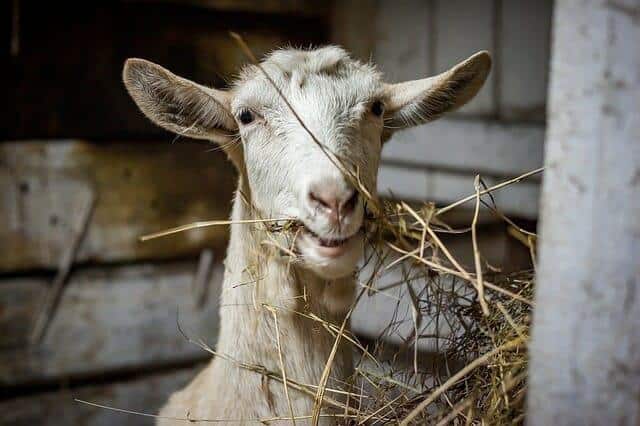Most Free Animals Are Male
Most of the animals you’ll see available for free are males. From intact buck goats and wethers to roosters, buck rabbits and drake ducks, nearly every farmer deals with an overabundance of boys from time to time.
So, why would you not want to take advantage of free males, especially if it’s a type of animal you might be planning to breed?
First, males given away for free are often not of the highest quality. They may be lacking proper bone structure, muscling, libido or markings. Even if they have these things, they may be past their prime, meaning low settling rates from either a low sperm count or diminished breeding hormones.
Second, males take more planning to house and care for. This is especially true of livestock that have a particular breeding season. Male goats can be quite destructive during the fall rut, even when running with a herd of females. Turkey toms that co-exist with other poultry through most of the year can be particularly aggressive at the beginning of the breeding season and may need to be separated.
Unsexed or Incorrectly Sexed
Craigslist and sale boards are full of free animal posts that start with the story of “we brought home two critters that were supposed to be males, and turns out one was a girl” or vice versa. Regrettably, not everyone who has livestock knows how to determine an animal’s sex. To get around it, animals will often be listed as “unsexed,” “straight run,” or as a “must take all” grouping. Sometimes an uneducated owner will just take a guess on sex entirely and give it away.
Be Prepared: Get The Ultimate In PORTABLE Solar Power!
To avoid unexpected complications down the road, know how to sex the animal you are planning to take in, or have a friend or family member that knows how help you.
Hidden Illnesses
Depending on the species, a critter may be carrying something that is infectious to other animals or even to others of its own kind.
A good example of this is chickens with fowl pox. When we lived in Mississippi, it was common for free chickens to be carrying the pox. With the pox, the chicken is fairly asymptomatic, meaning it doesn’t usually display the same blisters, respiratory issues or diminished appetite of other birds. What you will notice is that hens infected with it stop laying while the virus runs its course. However, like chicken pox in humans, it spreads easily, and will readily transmit to other poultry species where it does considerably more damage. From our experience, ducks and turkeys especially will develop lesions and blisters on their heads, around their eyes, and near their reproductive organs. In mild cases and healthy adult flocks, the effects can be pretty minimal, but fowl pox will easily kill chicks, juveniles, and can even cause the loss of fertility in adult breeders.
It’s not just chickens, of course. Often free rabbits are active carriers of Pasteurella, and your free goat may be positive for CL, CAE or even Johne’s Disease.
You can minimize the risk of bringing an infected animal home with a good biosecurity plan and a minimum quarantine of 30 days.
Reproductive Issues, Genetic Anomalies, or Bad Mothers
As an animal lover, we all get attached to our critters in one way or another. Unfortunately, this sometimes means that people will give away an animal that should really be culled due to reproductive problems or being known carriers of genetic issues.
Be sure to ask a lot of questions, especially if the animal previously had offspring. There are bad mothers in every species, from rejecting offspring, being inattentive, not having enough milk, or even killing them at birth.
Behavior Issues
Unfortunately, not everyone is honest about why they are getting rid of an animal. From being an escape artist, hating men/women, or attacking anything smaller than itself, critters with behavioral problems are often offered up as freebies for the unsuspecting.
A friend once brought home a beautiful one-year-old boer goat doe. She was purebred but given away without papers. The original owners had told my friend that they were just short on space, so they needed her to go, and that was why they had her penned up in a horse stall instead of out with the other goats. The doe was healthy, but my friend put her through quarantine anyway, though there were no issues. Once put out with the herd, this little doe became nothing but a problem child. She would escape from any paddock no matter how good the fence; she was insanely aggressive at feeding time; she would go out of her way to knock younger goat kids down. Then she turned on my friend’s 12-year-old granddaughter. It was the human aggression that earned the doe a trip to the butcher.
Bad Time of Year
Lastly, there is always an uptick in free animals during the winter months. This is mostly due to the increased costs to feed and/or the hassle of taking care of livestock during the cool, wet months. If you are willing to deal with a new addition to your homestead and have the facilities to keep it, be sure that you can afford to feed it. Both drought and wild fires can have impacts on the price and availability of everything from hay to bagged feeds.
With a little planning and know-how, you can avoid these free animal pitfalls. While we all enjoy adding livestock to our homesteads, just be sure they don’t end up costing you more in the long run.
What advice would you add? Share it in the section below:
